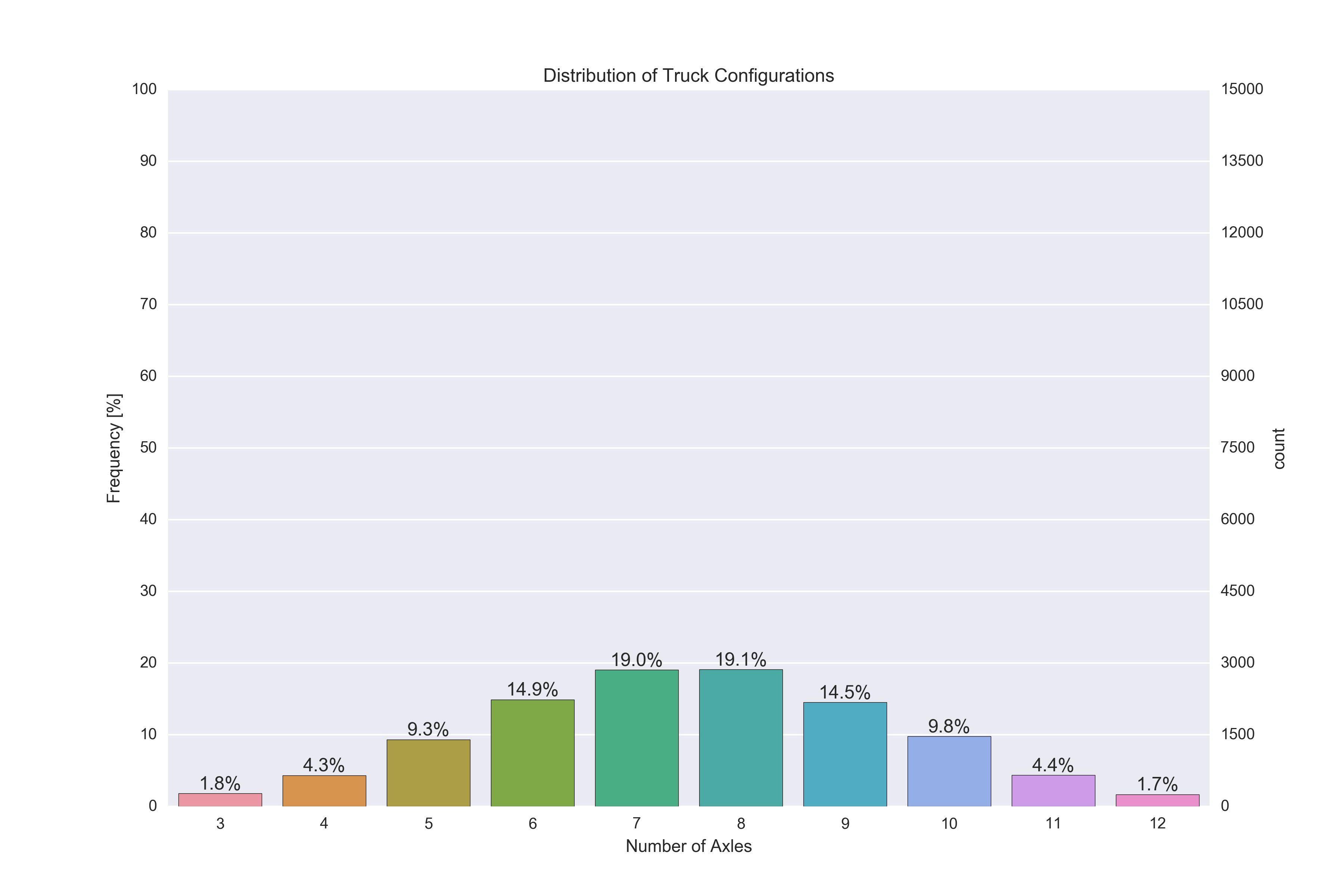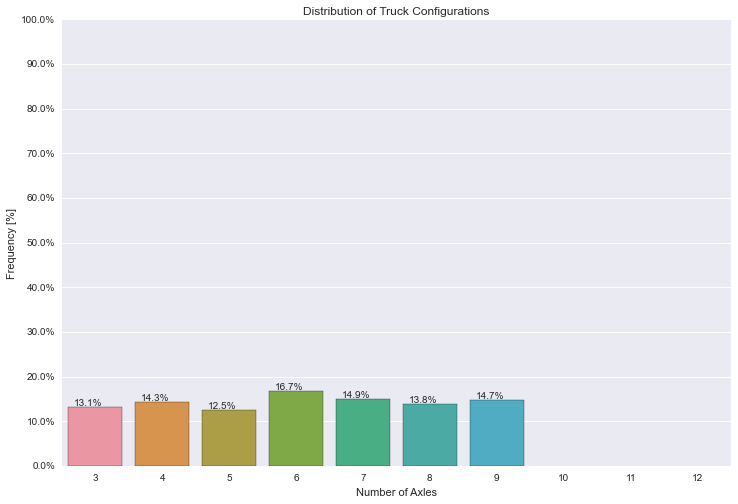Seaborn: countplot () с частотами
у меня есть фрейм данных Pandas со столбцом под названием "оси", который может принимать целочисленное значение между 3-12. Я пытаюсь использовать опцию countplot () Seaborn для достижения следующего сюжета:
- левая ось y показывает частоты этих значений, встречающихся в данных. Расширение оси - [0%-100%], деления через каждые 10%.
- правая ось y показывает фактические отсчеты, значения соответствуют делениям, определенным левой осью y (отмеченным на каждом 10%.)
- ось x показывает категории для гистограмм [3, 4, 5, 6, 7, 8, 9, 10, 11, 12].
- Аннотация В верхней части баров показывает фактический процент этой категории.
следующий код дает мне график ниже, с фактическими подсчетами, но я не мог найти способ преобразовать их в частоты. Я могу получить частоты, используя df.AXLES.value_counts()/len(df.index) но я не уверен, о том, как подключить эту информацию в .
Я также нашел обходной путь для аннотаций, но я не уверен, что это лучшая реализация.
любая помощь будет оценили!
спасибо
plt.figure(figsize=(12,8))
ax = sns.countplot(x="AXLES", data=dfWIM, order=[3,4,5,6,7,8,9,10,11,12])
plt.title('Distribution of Truck Configurations')
plt.xlabel('Number of Axles')
plt.ylabel('Frequency [%]')
for p in ax.patches:
ax.annotate('%{:.1f}'.format(p.get_height()), (p.get_x()+0.1, p.get_height()+50))
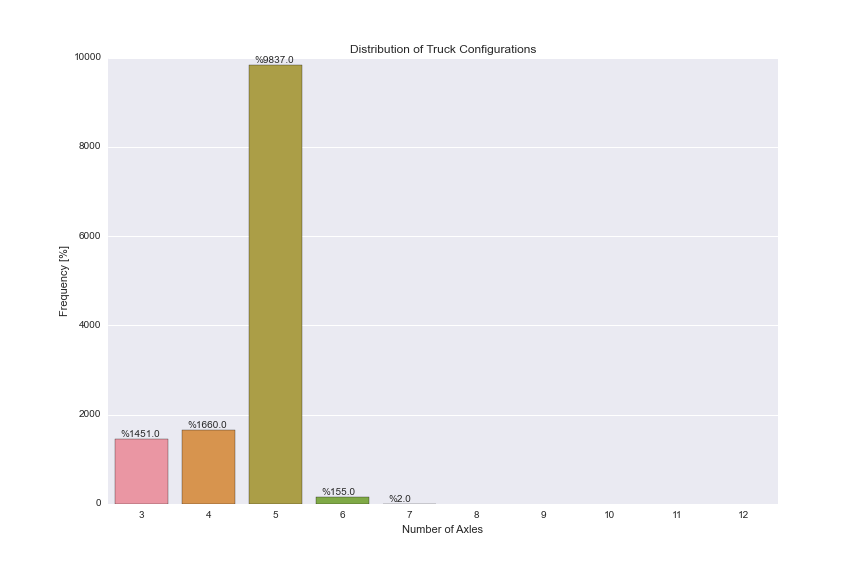
EDIT:
я приблизился к тому, что мне нужно со следующим кодом, используя заговор панды, бросая Seaborn. Похоже, я использую так много обходных путей, и должен быть более простой способ сделать это. Проблемы с этим подход:
- нет
orderключевое слово в функции гистограммы панды, как у countplot () Seaborn, поэтому я не могу построить все категории из 3-12, как я сделал в countplot(). Мне нужно, чтобы они были показаны, даже если в этой категории нет данных. -
вторичная ось y по какой-то причине испортила бары и аннотацию (см. белые линии сетки, нарисованные над текстом и палка.)
plt.figure(figsize=(12,8)) plt.title('Distribution of Truck Configurations') plt.xlabel('Number of Axles') plt.ylabel('Frequency [%]') ax = (dfWIM.AXLES.value_counts()/len(df)*100).sort_index().plot(kind="bar", rot=0) ax.set_yticks(np.arange(0, 110, 10)) ax2 = ax.twinx() ax2.set_yticks(np.arange(0, 110, 10)*len(df)/100) for p in ax.patches: ax.annotate('{:.2f}%'.format(p.get_height()), (p.get_x()+0.15, p.get_height()+1))
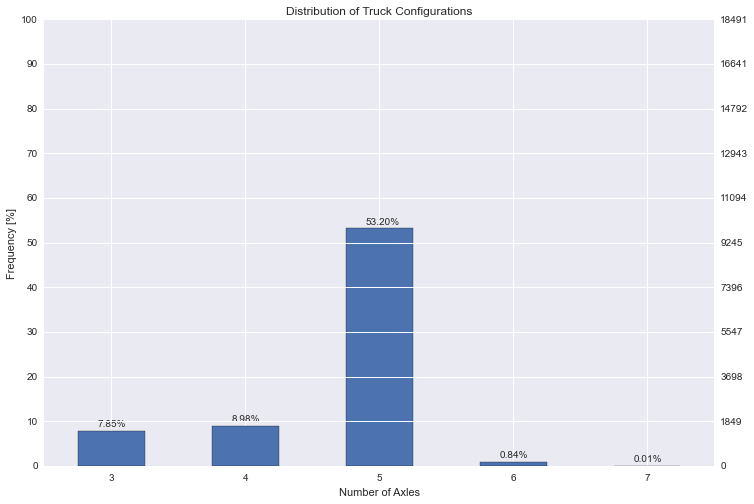
3 ответов
вы можете сделать это внеся twinx оси для частоты. Вы можете переключить две оси y вокруг, чтобы частоты оставались слева, а отсчеты справа, но без необходимости пересчитывать ось отсчетов (здесь мы используем tick_left() и tick_right() для перемещения клещей и set_label_position для перемещения меток оси
затем вы можете установить галочки с помощью matplotlib.ticker модуль, специально ticker.MultipleLocator и ticker.LinearLocator.
что касается ваших аннотаций, вы можете получить местоположения x и y для всех 4 углов панели с помощью patch.get_bbox().get_points(). Это, наряду с правильной установкой горизонтального и вертикального выравнивания, означает, что вам не нужно добавлять произвольные смещения в местоположение аннотации.
наконец, вам нужно отключить сетку для сдвоенной оси, чтобы предотвратить появление линий сетки поверх баров (ax2.grid(None))
вот рабочий скрипт:
import pandas as pd
import matplotlib.pyplot as plt
import numpy as np
import seaborn as sns
import matplotlib.ticker as ticker
# Some random data
dfWIM = pd.DataFrame({'AXLES': np.random.normal(8, 2, 5000).astype(int)})
ncount = len(dfWIM)
plt.figure(figsize=(12,8))
ax = sns.countplot(x="AXLES", data=dfWIM, order=[3,4,5,6,7,8,9,10,11,12])
plt.title('Distribution of Truck Configurations')
plt.xlabel('Number of Axles')
# Make twin axis
ax2=ax.twinx()
# Switch so count axis is on right, frequency on left
ax2.yaxis.tick_left()
ax.yaxis.tick_right()
# Also switch the labels over
ax.yaxis.set_label_position('right')
ax2.yaxis.set_label_position('left')
ax2.set_ylabel('Frequency [%]')
for p in ax.patches:
x=p.get_bbox().get_points()[:,0]
y=p.get_bbox().get_points()[1,1]
ax.annotate('{:.1f}%'.format(100.*y/ncount), (x.mean(), y),
ha='center', va='bottom') # set the alignment of the text
# Use a LinearLocator to ensure the correct number of ticks
ax.yaxis.set_major_locator(ticker.LinearLocator(11))
# Fix the frequency range to 0-100
ax2.set_ylim(0,100)
ax.set_ylim(0,ncount)
# And use a MultipleLocator to ensure a tick spacing of 10
ax2.yaxis.set_major_locator(ticker.MultipleLocator(10))
# Need to turn the grid on ax2 off, otherwise the gridlines end up on top of the bars
ax2.grid(None)
plt.savefig('snscounter.pdf')
Я получил его для работы с помощью core matplotlib's бар участок. Очевидно, у меня не было ваших данных, но адаптация их к вашим должна быть прямой.
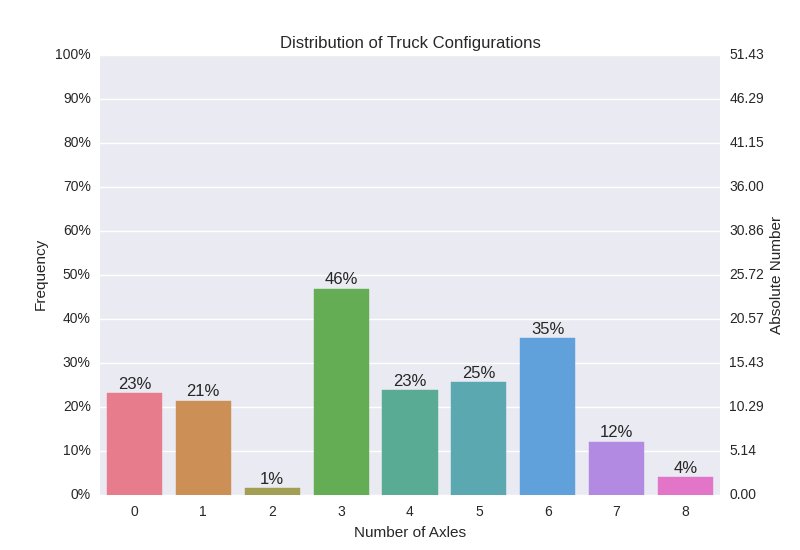
подход
Я matplotlibдвойная ось и построил данные в виде баров на втором Axes "объект". Остальные исть лишь некоторые fiddeling вокруг, чтобы получить право клещей и делать аннотации.
надеюсь, что это помогает.
код
import pandas as pd
import numpy as np
import matplotlib.pyplot as plt
import matplotlib
from mpl_toolkits.mplot3d import Axes3D
import seaborn as sns
tot = np.random.rand( 1 ) * 100
data = np.random.rand( 1, 12 )
data = data / sum(data,1) * tot
df = pd.DataFrame( data )
palette = sns.husl_palette(9, s=0.7 )
### Left Axis
# Plot nothing here, autmatically scales to second axis.
fig, ax1 = plt.subplots()
ax1.set_ylim( [0,100] )
# Remove grid lines.
ax1.grid( False )
# Set ticks and add percentage sign.
ax1.yaxis.set_ticks( np.arange(0,101,10) )
fmt = '%.0f%%'
yticks = matplotlib.ticker.FormatStrFormatter( fmt )
ax1.yaxis.set_major_formatter( yticks )
### Right Axis
# Plot data as bars.
x = np.arange(0,9,1)
ax2 = ax1.twinx()
rects = ax2.bar( x-0.4, np.asarray(df.loc[0,3:]), width=0.8 )
# Set ticks on x-axis and remove grid lines.
ax2.set_xlim( [-0.5,8.5] )
ax2.xaxis.set_ticks( x )
ax2.xaxis.grid( False )
# Set ticks on y-axis in 10% steps.
ax2.set_ylim( [0,tot] )
ax2.yaxis.set_ticks( np.linspace( 0, tot, 11 ) )
# Add labels and change colors.
for i,r in enumerate(rects):
h = r.get_height()
r.set_color( palette[ i % len(palette) ] )
ax2.text( r.get_x() + r.get_width()/2.0, \
h + 0.01*tot, \
r'%d%%'%int(100*h/tot), ha = 'center' )
Я думаю, вы можете сначала установить y основных тиков вручную, а затем изменить каждую метку
dfWIM = pd.DataFrame({'AXLES': np.random.randint(3, 10, 1000)})
total = len(dfWIM)*1.
plt.figure(figsize=(12,8))
ax = sns.countplot(x="AXLES", data=dfWIM, order=[3,4,5,6,7,8,9,10,11,12])
plt.title('Distribution of Truck Configurations')
plt.xlabel('Number of Axles')
plt.ylabel('Frequency [%]')
for p in ax.patches:
ax.annotate('{:.1f}%'.format(100*p.get_height()/total), (p.get_x()+0.1, p.get_height()+5))
#put 11 ticks (therefore 10 steps), from 0 to the total number of rows in the dataframe
ax.yaxis.set_ticks(np.linspace(0, total, 11))
#adjust the ticklabel to the desired format, without changing the position of the ticks.
_ = ax.set_yticklabels(map('{:.1f}%'.format, 100*ax.yaxis.get_majorticklocs()/total))

